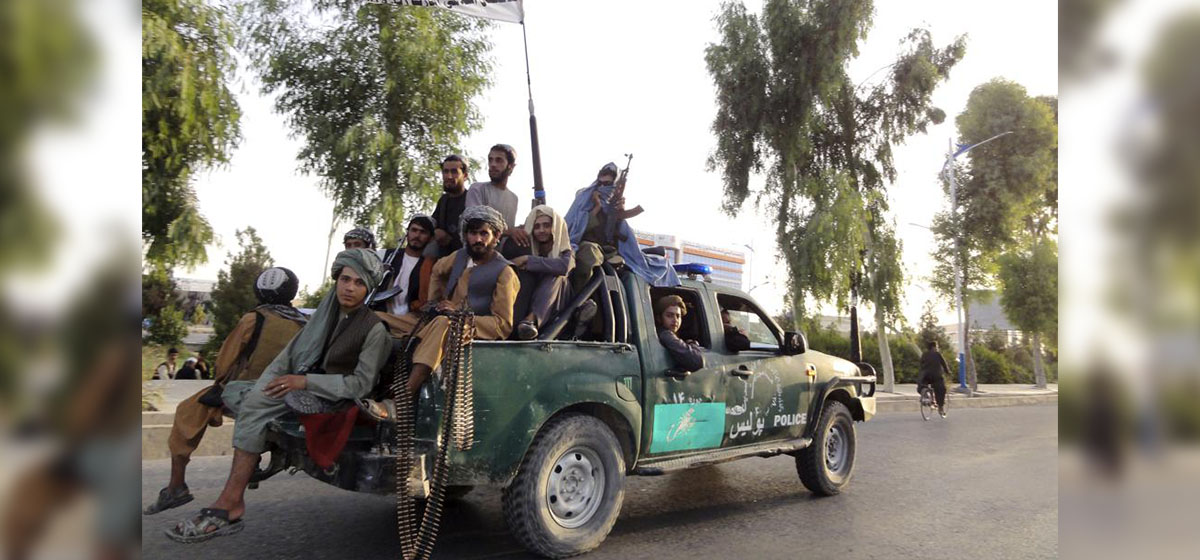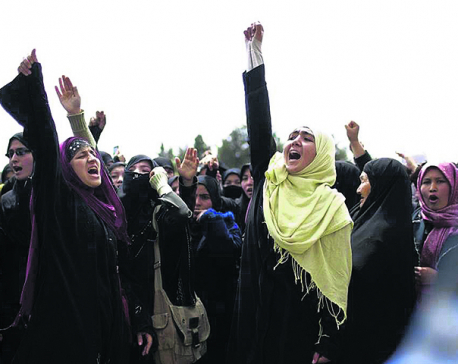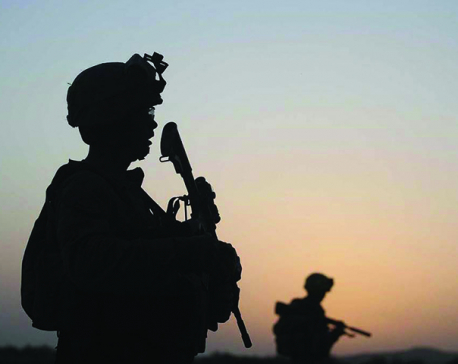
OR
Opinion
Taliban’s return to Kabul: Implications for South Asia and beyond
Published On: September 4, 2021 06:30 AM NPT By: Dinesh Bhattarai


Dinesh Bhattarai
Dinesh Bhattarai, former diplomat and foreign policy expert, has served as the foreign affairs adviser of former prime ministers Sher Bahadur Deuba and Sushil Koirala.news@myrepublica.com
The fall of Afghanistan to the Taliban carries enormous consequences for South Asia and beyond. Destabilization could start from there with Afghanistan once again becoming a safe haven for extremists working with their counterparts across the border in Pakistan. Developments in Afghanistan could significantly shift the balance of power and deepen the rivalry between the US and China.
The collapse of Kabul came on August 15 at a much faster pace and the Taliban emerged stronger than anticipated. Initially, the Taliban grew out of Madrassas in Pakistan in the 1990s. They were in charge of Afghanistan from 1996-2001 during which they sheltered transnational terrorists like Osama bin Laden, who masterminded the September 11 twin tower attacks in New York in 2001. For America there was an outpouring of support, and solidarity from around the world. France’s Le Monde editorialized, “We are all Americans.” Even the two arch-enemies -- the US and Iran -- reportedly maintained discreet and productive dialogue in the weeks following the September 11 attacks. The common cause was the global war on terror (GWOT). However, the discreet talks ended when President George W Bush labeled Iran as part of the ‘axis of evil,’ in January 2002 State of the Union Address.
President Bush in his public address on September 11, 2001 said, “Terrorist attacks can shake the foundation of our biggest buildings, but they cannot touch the foundation of America. These acts shattered steel, but they cannot dent the steel of American resolve.” While ordering the American army to strike military attacks in Afghanistan, President Bush said, “We defend not only our precious freedom but also the freedom of people everywhere to live and raise their children free from fear.” He assured the nation, “We will not waver, we will not tire, we will not falter, and we will not fail. Peace and freedom will prevail.”
Senator John McCain, who was taken as a prisoner of war during the Vietnam war, said on October 9, 2001, “No mountain is big enough, no cave deep enough to hide from the fury of American military power when we are committed to victory. We must not shrink from using it, in whatever measure necessary, to defeat our enemies, wherever they are.” Osama bin Laden had thought that American people would take to the streets against US military intervention in Afghanistan. Instead, a diverse America witnessed a surge of patriotism, and the American people rallied behind the President.
America fought the GWOT for 20 years, spent $2.313 trillion, the US military lost 2442 of its service members and 3936 US contractors. The number of civilians and opposition fighters killed during the war was 71,344 and 84,191 respectively. A total of 136 journalists and media workers, and 549 humanitarian aid workers were killed. America helped raise the Afghan army and run elected governments. In May 2011, U.S. special operations forces killed bin Laden during a raid on a compound in the Pakistani city of Abbottabad close to Pakistan’s premier military academy. Osama bin Laden was reportedly planned to carry out “martyrdom operations akin to the 9/11 attacks” but without success.
Laden’s afflictions and troubles were heart-rending and multiplying. Second tier leader Khalid al Habib put it in his 2004 letter to bin laden: “when God knew of our afflictions and helplessness, he opened the door of jihad for us and for the entire umma in Iraq.” In the winter of 2010-11, Osama bin Laden was reported to have said, “We cannot do anything except intensify our prayers.” Taliban temporarily retreated and continued their regrouping inside Afghanistan. An American professor Nelly Lahoud, who studied CIA declassified 470,000 digital files, wrote in Foreign Affairs (September-October 2021) that Al Qaeda’s mission was “to undermine the contemporary world order of nation-states and re-create the historical umma, the worldwide community of Muslims.” Attacks against the US embassies in Kenya and Tanzania in 1998, killing 224 and wounding more than 4000, were precursors to this.
How did the collapse come?
With the Taliban seizure of the remote city of Zarang, on August 6, the “lightning-speed advance” of the Islamist group was stunning. Things started to fall “more quickly than anticipated.” Twenty years’ achievements started to crumble in just one week. Afghan security forces numbering 350,000 offered no resistance, surrendered without a fight, gave up their weapons as Taliban promised amnesty to them. There was massive corruption and security forces’ morale was at a record low. A conversation over radios between an Afghan army officer and a Taliban commander was reported in which the Taliban commander taunted: “You are puppets of America!” The army officer shouted back: “You are the puppets of Pakistan!” The Taliban commander replied: “The Americans are infidels. The Pakistanis are Muslims.” The Afghan officer had no response.
Carter Malkasian, author of The American War in Afghanistan: A History who worked as political advisor to commander of all US forces in Afghanistan, records, “The Taliban fight for belief, for jannat (heaven) and ghazi (killing infidels). … The army and police fight for money.” A Taliban religious scholar from Kandahar told Malkasian in 2019. ‘The Taliban are willing to lose their heads to fight. … How can the army and police compete?” Several reports indicate, “ Taliban morale is better than government morale. Taliban morale is very high. Look at their suicide bombers. The Taliban motivate people to do incredible things.”
On February 29, 2020, a peace agreement was reached between the United States and the Taliban who promised “to prevent any group or individual, including al-Qaeda, from using the soil of Afghanistan to threaten the security of the United States and its allies.” Bypassing the Kabul government in Doha negotiations is also cited as one of the reasons for the speedy fall of Afghanistan to Taliban. Intelligent assessment that withdrawal will go in a “secure and orderly way” went wrong. The severity of conditions was all apparent with youths clinging to wings of an aircraft and US soldiers evacuating infant children.
Some see Kabul as “Biden’s Saigon,”- the humiliating fall of Saigon in 1975. “This is not Saigon,” US Secretary of State Antony Blinken, told CNN. “We went to Afghanistan 20 years ago with one mission, and that mission was to deal with the folks who attacked us on 9/11. And we succeeded in that mission.” President Biden reiterated that he “squarely” stands by his decision to bring all American men and women back home and said, “Afghan leaders have to come together. They have got to fight for themselves, fight for their nation,” and, “American troops cannot and should not be fighting in a war and dying in a war that Afghan forces are not willing to fight for themselves.”
After reaching Kabul, the head of the Taliban’s political office, Mullah Abdul Ghani Baradar, in a video message reportedly said, “In the past, we were not as responsible as we have become. It is now a test for us.” They assured in their first press conference that “they would not carry out reprisal killings or seize property; they would allow women to work and study but “within the bounds of Islamic law.” Taliban leaders have urged the fighters to treat conquered cities with benevolent hands. Given their past brutality, it is time to watch whether they walk the talk.
Former President Hamid Karzai, who was president from 2001-2014, urged a peaceful transition and advised both the security forces and the Taliban leaders to work together to maintain peace and order in the country. He along with Dr. Abdullah Abdullah and former Islamist warlord Gulbuddin Hekmatyar is reported to have formed a joint council to handle the transition. While President Ashraf Ghani fled the country, his vice president Amrullah Saleh is offering resistance from Panjshir valley in Afghanistan to the Taliban regime.
Implications on South Asia and the world
The fear from the fall of Afghanistan to the Taliban carries enormous consequences for South Asia and beyond. Destabilization could start from there with Afghanistan once again becoming a safe haven for extremists working with their counterparts across the border in Pakistan. Developments in Afghanistan could significantly shift the balance of power and deepen the rivalry between the US and China.
There are fears the Taliban in Kabul could embolden hardline jihadist groups, Islamic radicalism and terrorism in the neighbourhood and the region. Cross border terrorism and subversions could increase. John Allen, a former Commander of U.S.A., and allied forces in Afghanistan anticipates, “Al Qaeda operating from the Hindu Kush with US forces gone.” Foreign Affairs analyst Gideon Rachman writes “The Taliban’s defeat of the US will be a boost to jihadism across the globe, Taliban standing for guidance and inspiration.”
Recent UN reports indicated that the Taliban retain extensive ties with al Qaeda which was present in 15 Afghan provinces. Some of them are hiding in Federally Administered Tribal Areas (FATA) of Pakistan, an autonomous area bordering Afghanistan. Reports indicate the likelihood of them operating together along the Afghanistan-Pakistan border turning it a battlefield.
Taliban sheltered transnational terrorists in the past. Afghanistan’s immediate neighbours China, Iran, Pakistan, Central Asia, and near neighbour India, are all concerned that Taliban inspired violence could spill over to theirs’ restive provinces.
India spent $3 billion building roads, dams, power houses, health clinics, schools, libraries, parliament building in Afghanistan. With American departure from its backyard, India appears to have lost “strategic leverage.” The Economist writes, “India must face the prospect of a new generation of Muslim Kashmiris inspired by the Taliban’s fanaticism.”
On July 28, Chinese Foreign Minister Wang Yi met the head of the Afghan Taliban Political Commission, Abdul Ghani Baradar, who was reported to be falling in line with China’s demands. “The Afghan Taliban has the utmost sincerity to work toward and realize peace,” a Chinese statement released following the meeting said. “The Afghan Taliban will never allow any force to use the Afghan territory to engage in acts detrimental to China. The Afghan Taliban believes that Afghanistan should develop friendly relations with neighbouring countries and the international community.”
Beijing blames America's "hasty withdrawal" from Afghanistan for creating cross-border volatility and insecurity. With the Taliban's takeover, strategic calculus is changed. “China has benefited from the irresponsible behaviour of [the US], which has deeply undermined the international image of the US and the relationship between Washington and its allies,” said Zhu Yongbiao, a Chinese government adviser on central Asia and professor at Lanzhou University.
With American withdrawal, Washington’s rivals China and Russia are poised to step into the Afghan gap. Chinese President Xi Jinping and Russian President Vladimir Putin have agreed that the two countries will join hands to stabilize the situation in Afghanistan during their telephone conversation on August 25. Xi told Putin that China stands ready to strengthen communication and coordination with Russia and the broader international community on the Afghan issue.
When the Soviet Union invaded Afghanistan in 1979, it put the values of “socialism, equality and development” to win the hearts and minds of the Afghan people. A key reason for the collapse of Moscow’s empire is attributed to its intervention in Afghanistan. The intervention bled the Soviet Union, and withdrawal from Afghanistan was the midst of deep internal crisis, and people’s utter disappointment with their own system and governance. American arrival in 2001 was “to disrupt the use of Afghanistan as a terrorist base of operations and to attack the military capability of the Taliban regime.” “Enduring Freedom” was the name given to the US military mission. The mission expanded to “rebuilding the country” into a democracy and “propping up a government and military aligned with the US security interests.” Kissinger saw the weakening of political commitment in “the introduction of unfamiliar forms of government in Afghanistan which had deep corruption.” There is a new narrative now that only a negotiated settlement can bring a lasting end to over 40 years of conflict in Afghanistan.
Taliban victory is taken as a defeat of democracy. The US in Afghanistan showed that foreign policy based on armed approach alone will not work, nation building does not come at the barrel of a gun. The US will have to think of other methods “to promote stability and human warfare.” As President Biden prepares to convene Leaders’ Summit for Democracy on December 9 and 10, to “galvanize commitments and initiatives across three principal themes: defending against authoritarianism, fighting corruption, and promoting respect for human rights,” America shall have to show the power of example as the President has reiterated time and again, “We will lead not merely by the example of our power, but by the power of our example.”
The US withdrawal makes South Asia the most geo-strategically significant region in the world. It is likely that it could sow the seeds of a new Cold War between the US and China. Geopolitical trends put India and Pakistan in opposite directions. America is expected to play the so-called ‘China threat’ to rally India and friends behind it.
Afghanistan's location at the crossroads of Central, South and Southwest Asia makes it geopolitically attractive for all powers. The U.S. must be stopped, according to Chinese Foreign Minister Wang Yi, from "creating more problems and dumping the burden on regional countries." Reports indicate that China is determined to pursue cooperation with the Taliban to extract Afghanistan’s vast rare-earth metals that are estimated to be worth anywhere between $1 trillion and $3 trillion. America's exit opens doors for China to make strategic inroads into Afghanistan via Pakistan and deepen its penetration of Pakistan, Iran, and Central Asia.
Pakistan’s strategy will remain focused on consolidating its regional influence by leveraging its influence with the Taliban. Henry Kissinger wrote that the Taliban survived essentially in Pakistani sanctuaries. Pakistani Prime Minister Imran Khan was quoted to have said the Taliban have “broken the chains of slavery” with the West. Some even went to the extent of calling it “liberation”- amidst the signs of hundreds of thousands of Afghans rushing to flee their country.
The US president said, “America is back,” but it has pulled out of Afghanistan. The work of 20 years appears in complete disarray. Henry Kissinger wrote for The Economist, “the United States has torn itself apart in its counter insurgent efforts because of its inability to define attainable goals and to link them in a way that is sustainable by the American political process. The military objectives have been too absolute and unattainable and the political ones too abstract and elusive.” Taliban’s swift takeover of Afghanistan, and chaotic scene following withdrawal compels countries to rethink reliance on US security. Kissinger wrote “American rashness would compound disappointment among allies, encourage adversaries and sow confusion among observers.’’ Former US Secretary of State Condoleezza Rice writes in the Washington Post, “we have to live the consequences of our haste.” Security reliance on the US has raised a credibility question.
Foreign policy analyst Walter Russell Mead wrote in the Wall Street Journal: Pakistan is “the world’s only nuclear state with deep ties to terror groups. And its national security elite believes it is locked in an existential competition with India, its much larger, richer, and more technologically advanced southern neighbor. Yet Pakistan simply does not have the economic capacity to keep up this security competition.”
On October 17, 1985, Mikhail Gorbachev told the Politburo meeting, “it was time to end our involvement and withdraw,” from Afghanistan. America supplied the Mujahideen with stinger missiles that turned the tide against the Soviet troops. Though in the beginning of the global war on terror (GWOT), America and Russia’s interests were aligned in the beginning of the GWOT, as they both saw Al Qaeda and Islamist groups as threats. But as the war in Afghanistan dragged on, they took opposing positions. Russia, which faced humiliation in the 1980s, opened channels to the Taliban, and was reported aiding the insurgents, that included night vision goggles and armor-piercing ammunition. Russia’s covert efforts were seen aimed at harassing and embarrassing the United States.
There is a fluid environment. The entire world is keenly watching on what shape it will take, and power sharing in Taliban dispensation. The world fears Taliban’s brutality seen during 1996-2001. There will be a big question of legitimacy for the Taliban. Will they reform, will they moderate their fanatical impulses, are some of the questions that will haunt the Taliban. Their adherence to international obligations including respecting human rights for women and minorities will be watched closely and critically. Group of seven nations (G-7) said after a virtual leaders meeting “we will judge the Afghan parties by their actions, not words.” The twenty years of engagement is not without US footprints in Afghanistan. The defeat at the hands of the Taliban in Afghanistan is unlikely to further American decline. To achieve any progress in Afghanistan, goodwill, support, and cooperation from America would be required. The Taliban need to fully understand this. Their asking the US to retain its Embassy in Kabul is one sign towards that direction.
Choices for the future
The inhabitants of Afghanistan consist of different races and diverse nationalities with rival interests and antagonistic ambitions towards each other. British scholar and historian H.W. Bellew, chronicles that the inhabitants of Afghanistan are the Afghan, the Pathan, the Ghilzai, the Tajik and the Hazarah along with Uzbeks, Turkmans, Pamiris, Arabs and Gujars. He traces religion as the only common bond of union among them. Afghan diversity is not reflected in Pathans alone, and Afghanistan as a nation has considerable risks if it becomes Talibanistan. All people should have access to food, education, health and a sense of togetherness belonging to Afghanistan.
There are several extremist groups such as the Islamic State (ISIS) and al Qaeda hiding in Afghanistan. ISIS-Khorasan (ISIS-K)-an offshoot of ISIS and enemies of the Taliban claimed responsibility for the Kabul airport bombings which took the toll over 110 people including the thirteen US military personnel- the single day highest toll since 2011. There is a possibility of countries that view the Islamic State as an increasing threat to an orderly world, coming together to protect their interests. Gen. Frank McKenzie, head of the US Central Command was reported saying after airport attacks, the 5,200 American forces in Afghanistan “use the Taliban as a tool to protect us as much as possible.” The Taliban and the US, he added, now share a “common purpose.” Financial Times (London) editorialized that “Washington will rely on the Taliban as local enforcer, a foe it has fought for two decades.”
The return of the Taliban to Kabul is a wakeup call for South Asia and beyond. The first victim of political instability and uncertainty in Afghanistan would be South Asian countries.They run the risks of becoming prey to global strategic rivalries. Before the geopolitical situation goes extraordinarily dangerous with the possibility of engulfing the entire region-which is at the center of the rapidly shifting global power- countries in the region have to come together to save South Asia for the larger benefit of the region. Regional grouping in South Asia, South Asian Association for Regional Cooperation (SAARC) that remains sidelined and dormant since the 18thsummit meeting of 2014 in Kathmandu, should be revived and given a role to play, as no other alternative capable of bringing together South Asian countries for mutually beneficial diplomacy remains in sight. SAARC needs to be freed from pulls and pressures of member states and brought to work to save South Asia.
With Afghanistan in the Taliban’s control, focus should be to work for the avoidance of humanitarian catastrophe and political turmoil, advance intra-Afghan talks and Afghanistan's peace and reconstruction. To ensure that Afghanistan does not become a destabilizing force for the region and beyond, it is time to work together to stop tricks and avoid geopolitical traps.
For Nepal, there could be no higher priority than to secure the safe passage of the Nepali nationals in Afghanistan. Nepal should watch the unfolding developments closely, carefully, critically, and comprehensively and add her voice for an Afghanistan that remains united amidst diversity, peaceful, representative, and inclusive that represents the will of all Afghan people including with the full and meaningful participation of women. Afghan national unity and reconciliation stands as the only way to keep the nation together and dignity of Afghan people in an atmosphere free from foreign interference, jihadist extremism , drug menace and warlordism.
You May Like This

Afghanistan’s forgotten half
While Afghan women made huge strides in 2001, much more remains to be done ... Read More...

Agonizing over Afghanistan
America’s policy in Afghanistan should be one that avoids the risks of a rapid, unconditional exit but also minimizes the costs... Read More...

Laws of rule
If we did not have strong guardianship of the Supreme Court, the rights of the individuals would have been grossly... Read More...







Just In
- Rain shocks: On the monsoon in 2024
- Govt receives 1,658 proposals for startup loans; Minimum of 50 points required for eligibility
- Unified Socialist leader Sodari appointed Sudurpaschim CM
- One Nepali dies in UAE flood
- Madhesh Province CM Yadav expands cabinet
- 12-hour OPD service at Damauli Hospital from Thursday
- Lawmaker Dr Sharma provides Rs 2 million to children's hospital
- BFIs' lending to private sector increases by only 4.3 percent to Rs 5.087 trillion in first eight months of current FY












Leave A Comment